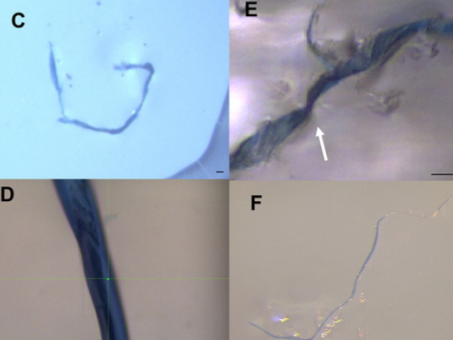Blue denim jean microfibres found in remote Arctic
Around 50,000 microscopic fibres are shed from a single pair of jeans each time they are washed

Your support helps us to tell the story
From reproductive rights to climate change to Big Tech, The Independent is on the ground when the story is developing. Whether it's investigating the financials of Elon Musk's pro-Trump PAC or producing our latest documentary, 'The A Word', which shines a light on the American women fighting for reproductive rights, we know how important it is to parse out the facts from the messaging.
At such a critical moment in US history, we need reporters on the ground. Your donation allows us to keep sending journalists to speak to both sides of the story.
The Independent is trusted by Americans across the entire political spectrum. And unlike many other quality news outlets, we choose not to lock Americans out of our reporting and analysis with paywalls. We believe quality journalism should be available to everyone, paid for by those who can afford it.
Your support makes all the difference.Minuscule fibres from blue denim jeans, the world’s most popular clothing item, have been found in the remote Arctic according to a new study, another sign of the far-reaching footprint of man-made materials on ocean life.
Around 50,000 microscopic fibres, or microfibres, are shed from a single pair of jeans each time they are washed. Although most are captured by wastewater treatment plants, some still end up in rivers, lakes and oceans via wastewater discharge, known as effluent.
Based on the levels of microfibres found in the effluent, the research team estimated that the treatment plants in the study discharged about 1 billion indigo denim microfibres each day.
The research, published on Wednesday in the American Chemical Society’s Environmental Science & Technology Letters, found that indigo denim accounted for 20 per cent of all microfibres in sediments from the Canadian Arctic Archipelago, a region just south of Greenland.
Indigo denim also accounted for 23 per cent of all microfibres in sediments from the Great Lakes and 12 per cent of those in shallow lakes near Toronto, Canada.
The researchers used both microscopy and Raman spectroscopy to identify and count indigo denim microfibres in samples collected from the different bodies of water. Raman spectroscopy scatters light from a high-intensity laser which at a certain frequency reveals characteristics of a molecular structure.

At any moment, half the world is wearing blue jeans or other denim clothing, according to the study. And despite brands recommending washing jeans once a month, the research team, from the Department of Earth Sciences and School of the Environment at University of Toronto, noted that most Canadians wash their pair after wearing them just twice.
Due to blue jeans’ popularity, and the amount of time the garments were spending in washing machines, researchers were curious as to whether they were a major source of microfibres in aquatic environments.
Blue jean denim is made up of “natural cotton cellulose fibres, processed with synthetic indigo dye and other chemical additives to improve performance and durability”, the study found.
The study noted that while denim microfibres are “natural”, since they are treated with chemical processes, accumulation in natural environments could pose risks to animal and plant life.
Overall, microfibres comprised 87−90 per cent of the anthropogenic — or man-made — particles found in sediments from the Canadian Arctic Archipelago, Laurentian Great Lakes, along the US-Canada border, and the shallow, suburban lakes in southern Ontario.
Although around a fifth of microfibres found in the Great Lake region were denim, only a single denim microfibre was found in the digestive tract of a rainbow smelt, a popular species for both commercial and sport fishing.
The study adds to a growing body of research, which shows the impact that man-made materials have on marine environments. One study last month found that 10 times more plastic pollution has been dumped in the Atlantic Ocean than previously believed.
“We conclude that blue jeans, the world’s single most popular garment, are an indicator of the widespread burden of anthropogenic pollution by adding significantly to the environmental accumulation of microfibers from temperate to Arctic regions,” the researchers noted.
The University of Toronto team suggested that washing machine filters may be one way to mitigate the volume of microfibres entering waterways. Another simple solution? Washing jeans less frequently.
Join our commenting forum
Join thought-provoking conversations, follow other Independent readers and see their replies
Comments